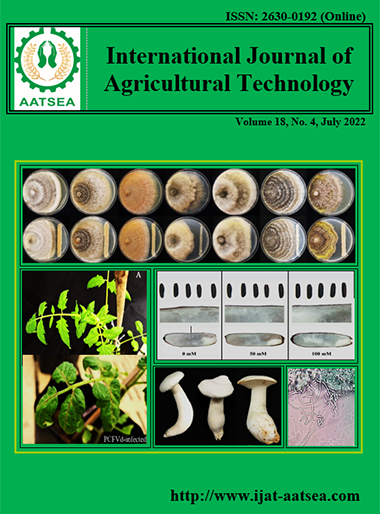Biotechnological potential of phosphate-solubilizing Pseudomonas migulae strain GEOT18
Main Article Content
Abstract
The biotechnological potential of phosphate-solubilizing bacterial Pseudomonas migulae strain GEOT18, isolated from the endosphere of Dactylorhiza incarnata (L.) Soó (Orchidaceae Juss) was investigated. The phosphate solubilizing activity of this strain was assessed qualitatively and quantitatively by their ability to dissolve tricalcium phosphate. It was established that the Pseudomonas migulae GEOT18 demonstrated strong phosphate-solubilizing activity (the content of free phosphorus in the culture medium was 3.25 ± 0.05 mg/ml). It was revealed that P. migulae GEOT18 synthesizes indole-3-acetic acid into the culture medium up to 21.1 ± 1.4 mg/L. Furthermore, it was established that this strain produces siderophores, can fix molecular nitrogen and does not show phytopathogenic activity. It was proved that inoculation of the marigold Tagetes patula with the P. migulae GEOT18 strain increases the biomass of plants and mass of inflorescence. It accelerates the transfer to the generative phase and prolongs the duration of flowering and fruiting in comparison with non-inoculated plants.
Article Details

This work is licensed under a Creative Commons Attribution-NonCommercial-NoDerivatives 4.0 International License.
References
Alexander, B. D. and Zeeberi, D. A. (1991). Use of chromazurol S to evaluate siderophore production by rhizosphere bacteria. Biology and Fertility of Soils, 2:39-54.
Babu, A. N., Jogaiah, S., Ito, S. I., Nagaraj, A. K. and Tran, S. P. (2015). Improvement of growth, fruit weight and early blight disease protection of tomato plants by rhizosphere bacteria is correlated with their beneficial traits and induced biosynthesis of antioxidant peroxidase and polyphenol oxidase. Plant Science, 231:62-73.
Bhattacharyya, P. and Jha, K. D. (2012). Plant growth-promoting rhizobacteria (PGPR): emergence in agriculture. World Journal of Microbiology and Biotechnology, 28:1327-1350.
Butterly, C. R., Bunemann, E. K., McNeill, A. M., Baldock, J. A. and Marschner, P. (2009). Carbon pulses but not phosphorus pulses are related to decrease in microbial biomass during repeated drying and rewetting of soils. Soil Biology and Biochemistry, 41:1406-1416.
Fürnkranz, M., Müller, H. and Berg, G. (2009). Characterization of plant growth promoting bacteria from crops in Bolivia. Journal of Plant Diseases and Protection, 116:159-155.
Hanif, M. K., Hameed, S., Imran, A., Naqqash, T., Shahid, M. and Van Elsas, J.D. (2015). Isolation and characterization of a β-propeller gene containing phosphobacterium Bacillus subtilis strain KPS-11 for growth promotion of potato (Solanum tuberosum L.). Frontiers in Microbiology, 6:1-12.
Hussain, A., Zia, M. and Mirza, B. (2007). Cytotoxic and antitumor potential of Fagonia cretica L. Turkish Journal of Biology, 31:19-24.
Jensen, H. L. (1942). Nitrogen fixation in leguminous plants. I.General characters of root-nodule bacteria isolated fromspecies of Medicago and Trifolium in Australia. Proceedings of the Linnean Society of New South Wales 67: 98-108.
Khan, M. S., Zaidi, A., Ahemad, M., Oves, M. and Wan, P. A. (2010). Plant growth promotion by phosphate solubilizing fungi–current perspective. Archives of Agronomy and Soil Science, 56:73-98.
Kim, Y. C., Leveau, J., McSpadden Gardener, B. B. and Pierson, E. A. (2011). The multifactorial basis for plant health promotion by plant-associated bacteria. Applied and Environmental Microbiology, 77:1548-1555.
Klopper, J. W., Lifshitz, R. and Zablotowicz, R. M. (1989). Free-living bacterial inocula for enhancing crop productivity. Trends in Biotechnology, 7:39-43.
Li, Y., Zhang, J., Zhang, J., Xu, W. and Mou. Z. (2019). Characteristics of Inorganic Phosphate-Solubilizing Bacteria from the Sediments of a Eutrophic Lake. International Journal of Environmental Research and Public Health, 16:2-15.
Mehnaz, S., Mirza, M. S., Haurat, J., Bally, R., Normand, P., Bano, A. and Malik, K. A. (2001). Isolation and 16S rRNA sequence analysis of the beneficial bacteria from the rhizosphere of rice. Canadian Journal of Microbiology, 47:110-117.
Murphy, J. and Riley, J. P. (1962). A modified single solution method for the determination of phosphate in natural waters. Analytica Chimica Acta, 27:61-6.
Oteino, N., Lally, R. D., Kiwanuka, S., Lloyd, A., Ryan, D., Germaine, K. J. and Dowling, D .N. (2015). Plant growth promotion induced by phosphate solubilizing endophytic Pseudomonas isolates. Frontiers in Microbiology 6(745). Retrieved from https://www.frontiersin.org/articles/10.3389/fmicb.2015.00745/full
Puri, A., Padda, K. P. and Chanway, C. P. (2018). Nitrogen-fixation by endophytic bacteria in agricultural crops: recent advances. World's largest Science Technology & Medicine, 5:73-94.
Rassokhina, I. I., Platonov, A. V. and Marakaev, O. A. (2020). Influence of Pseudomonas sp. GEOT18 strain, isolated from underground bodies of Dactylorhiza incarnata (L.) Soo (Orchidaceae Juss) on growth processes of cultural plants. International Research Journal, 6–2:20-24.
Rodríguez, H. and Fraga, R. (1999). Phosphate solubilizing bacteria and their role in plant growth promotion. Biotechnology Advances, 17:319-339.
Saini, S., Sharma, I., Kaur, N., Pati, P. K. (2013). Auxin: A master regulator in plant root development. Plant Cell Report, 32:741-757.
Sambrook, J. and Russell, D. W. (2001). Molecular cloning: A laboratory manual. 2nd ed. Cold Spring Harbor: Cold Spring Harbor Laboratory Press, 2222 p.
Schwyn, B and Neilads, J. B. (1987). Universal chemical assay for the detection and determination of siderophores. Analytical Biochemistry, 160:47-5.
Sharma, R., Pal, J. and Kaur, M. (2017). Isolation of phosphate solubilizing Pseudomonas strains from apple rhizosphere in the Trans Himalayan region of Himachal Pradesh. Retrieved from https://doi.org/10.1101/193672;
Sharma, S. B., Sayyed, R. Z., Thivakaran, A. and Trivedi, M. (2013). Phosphate solubilizing microbes: sustainable approach for managing phosphorus deficiency in agricultural soils. SpringerPlus, 2:587.
Subramanium, N. and Sundaram, L. (2020). Siderophore producing Pseudomonas spp. isolated from rhizospheric soil and enhancing iron content in Arachis hypogaea L. plant. International Journal of Agricultural Technology, 16:429-442.
Suleman, M., Yasmin, S., Yahya, M, Atta, B. M. and Mirz, M. S. (2018). Phosphate solubilizing bacteria with glucose dehydrogenase gene for phosphorus uptake and beneficial effects on wheat. Plosone, 13(9). Retrieved from https://doi.org/10.1371/journal.pone.0204408
Tsavkelova, E. A., Cherdyntseva, T. A., Botina, S. G. and Netrusov, A. I. (2007). Bacteria, associated orchid roots and microbial production of auxin. Microbiological Research, 162:69-76.
Yin, Y. (2011). Screening of phosphorus-solubilizing strain and its phosphate dissolving mechanism. Master dissertation, Dalian University of Technology, Dalian.
Zhao, Y. (2010). Auxin biosynthesis and its role in plant development. Annual Review of Plant Biology, 61:49-64.


